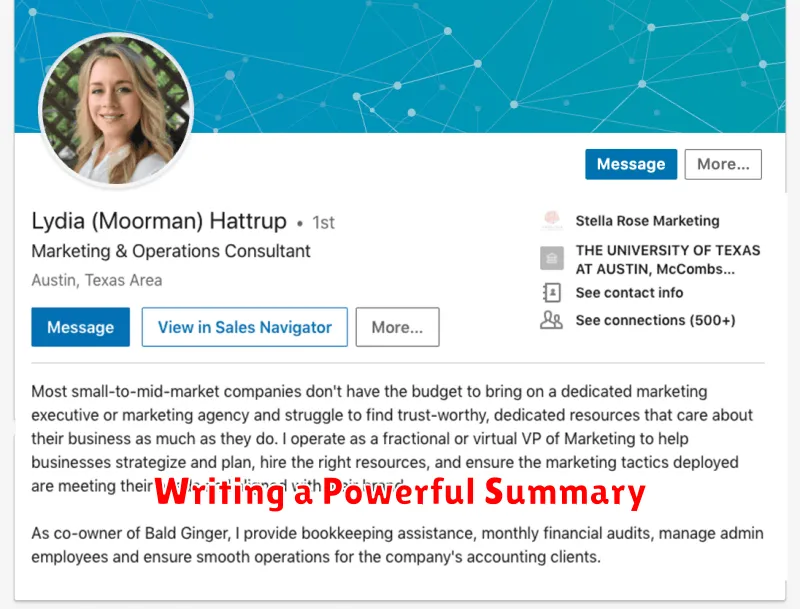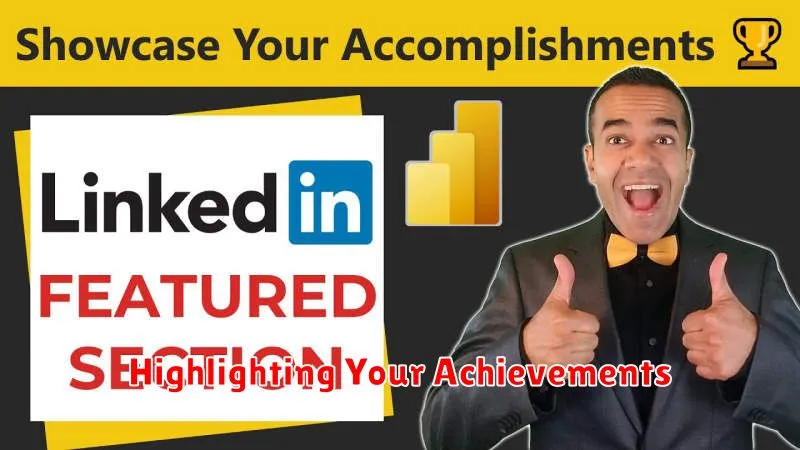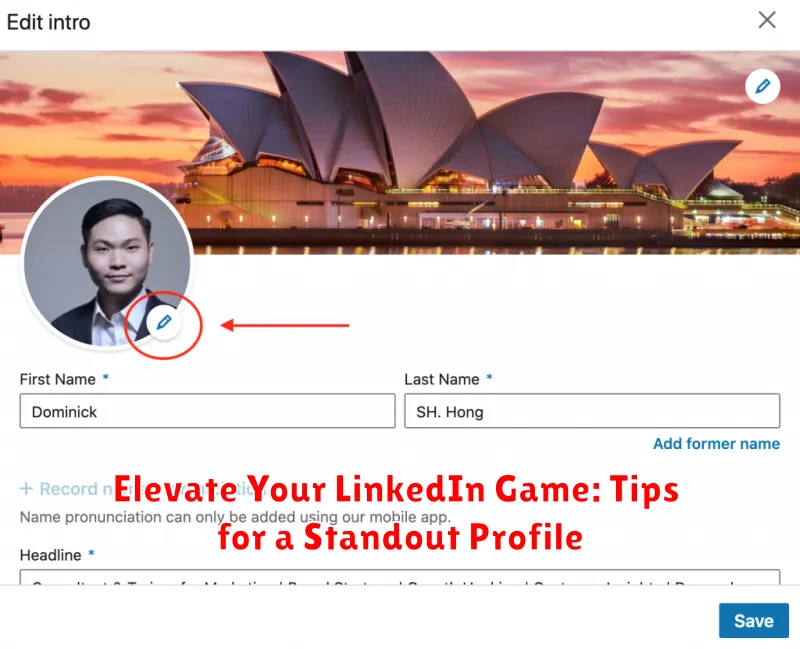In today’s competitive job market, a strong online presence is crucial. LinkedIn, the world’s leading professional networking platform, provides an unparalleled opportunity to connect with potential employers, showcase your skills, and build your professional brand. A compelling LinkedIn profile is no longer optional; it’s a necessity for career advancement. This article provides actionable tips to elevate your LinkedIn game and create a standout profile that captures attention and opens doors to new opportunities. Learn how to optimize your profile, making it a powerful tool in your job search and career development journey.
Crafting a standout LinkedIn profile requires a strategic approach. From optimizing your headline and summary to showcasing your experience and skills effectively, every element plays a crucial role. This guide will delve into the essential elements of a successful LinkedIn profile, offering practical advice and tips to help you stand out from the crowd. Discover how to maximize the impact of your profile and position yourself for success in the digital age. Elevate your LinkedIn game and unlock the full potential of this powerful platform.
Optimizing Your LinkedIn Profile
Your LinkedIn profile serves as your digital resume, a powerful tool for professional branding and networking. A well-optimized profile significantly increases your visibility to recruiters, potential clients, and collaborators. It’s the key to unlocking new opportunities and advancing your career.
Optimization involves strategically crafting each section of your profile to present a cohesive and compelling narrative of your professional journey. This includes ensuring your profile is complete, accurate, and up-to-date, reflecting your current role, skills, and aspirations. A polished and professional profile demonstrates your commitment to your career and leaves a lasting positive impression.
Regularly reviewing and updating your profile is crucial. The job market and your skills are constantly evolving, and your profile should reflect this growth and development. Consider your profile a dynamic document, subject to ongoing refinement and improvement.
Crafting a Compelling Headline
Your headline is the first impression you make on LinkedIn. It’s the short, attention-grabbing snippet of text that appears directly under your name. A generic headline won’t cut it. Instead of simply stating your current job title, use this valuable space to showcase your unique value proposition.
Think of your headline as a mini-resume summary. Clearly and concisely communicate your expertise and target audience. Use keywords relevant to your industry and desired roles. For example, instead of “Marketing Manager,” try “Marketing Manager | Driving Growth Through Digital Strategies | B2B SaaS.” This more specific headline highlights your skills and the type of companies you’re interested in.
Avoid jargon and buzzwords. Focus on clarity and impact. Make it easy for recruiters and potential connections to understand what you do and how you can add value.
Regularly update your headline to reflect your current career goals and aspirations. As you progress in your career, your headline should evolve with you.
Showcasing Your Skills and Experience
The “Experience” section is the core of your LinkedIn profile. It’s where you demonstrate the value you bring to the table. Go beyond simply listing your responsibilities. Instead, focus on the impact you made in each role. Use the STAR method (Situation, Task, Action, Result) to showcase your accomplishments and quantify your achievements whenever possible. Numbers and data speak volumes.
Quantify your accomplishments with metrics and data. Instead of saying “Managed a team,” say “Managed a team of 15, exceeding quarterly goals by 12%.” This adds credibility and demonstrates the tangible value you delivered.
The “Skills” section reinforces your expertise. Add both hard and soft skills relevant to your desired roles. Consider endorsing skills of your connections and requesting endorsements in return to build credibility. Don’t forget to take skill assessments offered by LinkedIn to validate your proficiency.
Choosing the Right Profile Picture
Your profile picture is the first impression you make on LinkedIn. A professional and approachable photo is crucial for building credibility and attracting connections. Think of it as your digital handshake.
Opt for a recent, high-quality headshot where you’re smiling naturally. Your face should be clearly visible and take up the majority of the frame. Avoid selfies, heavily filtered images, or pictures with distracting backgrounds. A simple, uncluttered background works best.
Dress professionally in attire that aligns with your industry. The goal is to present yourself as you would in a professional setting.
Consider investing in a professional headshot. A photographer can help you achieve the right lighting, composition, and overall look that conveys professionalism and confidence.
Writing a Powerful Summary

Your LinkedIn summary is your chance to make a strong first impression. It’s the space to articulate your unique value proposition and career aspirations. Think of it as your elevator pitch in written form. Keep it concise and engaging, highlighting your most relevant skills and experiences.
Begin with a captivating opening line that grabs the reader’s attention. Clearly state your professional identity and what you’re passionate about. Focus on the value you bring to potential employers or collaborators. Briefly mention key accomplishments and quantify your achievements whenever possible.
Use keywords relevant to your industry to enhance your profile’s searchability. Avoid jargon and clichés, opting for clear and concise language. Proofread carefully for any grammatical errors or typos. A polished summary reflects professionalism and attention to detail.
Building Your Network
A strong LinkedIn network is crucial for career advancement. Actively connect with people you know, including colleagues, classmates, and clients. Don’t be afraid to reach out to individuals in your industry, even if you haven’t met them personally. A personalized invitation explaining your shared interests is more likely to be accepted.
Join relevant LinkedIn groups. These groups provide a platform for industry discussions, job postings, and networking opportunities. Participate in conversations and share your insights to establish yourself as a thought leader and connect with like-minded professionals. Engage thoughtfully, focusing on adding value to the conversation.
Regularly interact with your network’s content. Liking, commenting, and sharing posts from your connections keeps you top of mind and strengthens your relationships. This consistent engagement demonstrates your interest in their work and builds a sense of community.
Engaging with Content
Active engagement is key to maximizing your LinkedIn presence. Regularly interacting with content within your industry helps establish you as a thought leader and keeps your profile visible.
Share insightful articles and publications relevant to your field. Add a brief, personal commentary to demonstrate your understanding and perspective. This sparks conversation and encourages others to engage with your posts.
Join relevant groups and participate in discussions. Offer valuable contributions, answer questions, and share your expertise. This establishes credibility and expands your network.
React and comment on posts from your connections. Thoughtful responses can lead to valuable connections and discussions. Liking and reacting shows support for your network and keeps you active in their feeds.
Highlighting Your Achievements

Don’t let your accomplishments go unnoticed. LinkedIn provides several features to showcase your achievements and demonstrate your value to potential employers and connections. Actively highlighting your accomplishments sets you apart and provides concrete evidence of your capabilities.
The “Accomplishments” Section: This section allows you to add various achievements, including publications, patents, courses, projects, honors & awards, test scores, languages spoken, and organizations you’re involved with. Utilize this section to its fullest potential by adding relevant achievements that demonstrate your skills and experience.
Quantify Your Impact: Whenever possible, quantify your achievements with metrics and numbers. Instead of saying “Improved sales,” say “Increased sales by 15% in Q2.” Providing quantifiable results provides a clearer picture of your impact and strengthens your credibility.
Featured Section: Use the featured section to showcase your most impressive work. You can add posts, articles, media, and documents that highlight your skills and accomplishments. This is a prime opportunity to visually represent your contributions and provide further context to your experience.
Using Keywords Strategically
Keywords are crucial for getting discovered by recruiters and potential connections on LinkedIn. Think of them as the bridge connecting your profile to opportunity.
Identify the key skills and terms relevant to your desired roles. Research industry-standard terminology and incorporate these keywords throughout your profile.
Strategically weave keywords into your headline, summary, experience section, and skills section. Don’t just list them; use them in context to demonstrate your proficiency.
Avoid keyword stuffing, which is overusing keywords to the point where it sounds unnatural. Focus on organic integration for a professional and effective approach.

